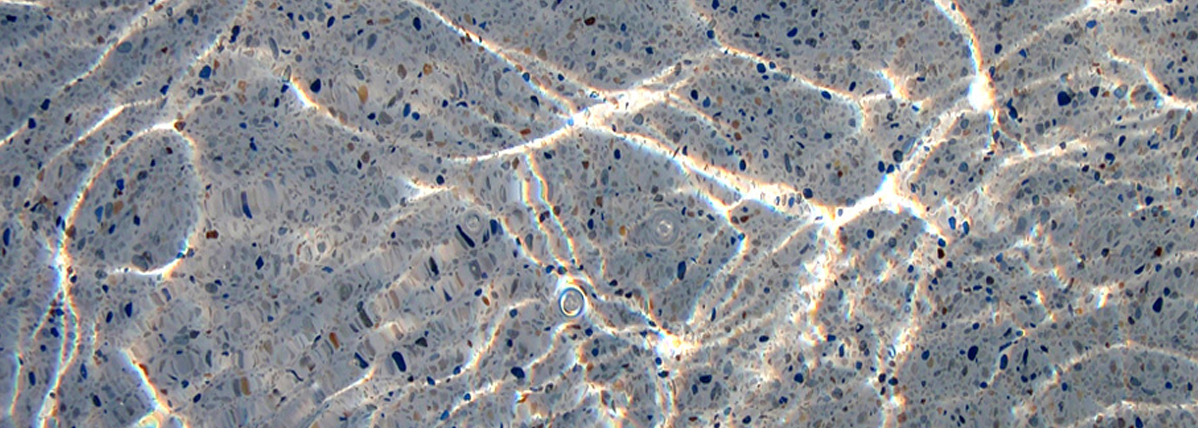SALT WATER SANITATION SYSTEMS
SALT WATER POOLS
To be absolutely clear, there are sea water pools, meaning pools that are filled with ocean water. These are not so common and are typically located right at the coast. Sea water pools require special equipment and surfaces to withstand the very briny 35,000 parts per million (ppm) of salt found in the ocean. There are also additional filtration and maintenance concerns as sea water contains many components (minerals, algae, and other organics) not found in the public tap or well water used to fill most pools.
HOW MUCH SALT
Salt water pools are quite different, with only about 3,000 ppm of salt. This concentration is below the threshold detectable to human taste buds and will not leave any noticeable salty residue on skin and hair. Liken it to the saline solution used for contact lenses. So, while bathers may swim and relax oblivious to its presence, the salt is involved in some complex chemical reactions in order to create chlorine.
THE SCIENCE BEHIND THE SALT
Salt is added to pool water in conjunction with the installation of a salt chlorine generator. The generator is comprised of a power supply which is wired at the pool equipment pad and a salt cell which is plumbed inline with the pipe returning water to the pool. Inside the salt cell are coated metal blades which receive a low voltage current. As salt water passes through, electrolysis occurs, splitting the salt and water into hydrogen and hypochlorous acid. This acid replaces the chlorine tablets or granules traditionally used to sanitize pools.
This process repeats indefinitely as the salt converts to acid and then the acid converts back to salt. Salt does not evaporate. Therefore, once the proper ppm of salt is reached, only small amounts of salt are required to adjust levels. Some things that affect salt levels are heavy rain, which dilutes the concentration of salt, or heavy pool usage (think pool party), when a significant amount of water might be splashed out of the pool.
HIGH QUALITY CHLORINE
The chlorine produced by this electrolytic process is less harsh than the traditional “tri-chlor” chlorine used for pools. Chlorine created from salt does not smell like bleach, and is very gentle to skin, hair and swim suits. The water has a softer feel. These are the more aesthetic benefits of using a salt chlorine generator. Other pros include not having to buy, handle or store buckets of chlorine. It is also considered to be a purer and therefore healthier form of chlorine, for those interested in limiting their exposure to this potent chemical.
IS SALT RIGHT FOR YOU?
If you’re considering a salt pool, here are some factors to weigh. First is the initial expense of the generator. This generally ranges from about $2000 – $3500 depending on your pool size, and how many bells and whistles you require. Some salt systems include automation to control all of your pool equipment and these can cost considerably more. Energy usage comes into play as well; a salt chlorinator only produces chlorine when the pool pump is running. You will also have the initial expense of many pounds of salt to get the pool up to the proper ppm; once that is done, salt maintenance is typically minimal and not very expensive.
Second, you will need to replace the salt cell, generally every 3 – 5 years. Replacement cell prices are in the neighborhood of $500 – $1000. If you live in a warmer region where your pool is open year round, you might need to replace the cell more frequently.
Third, it is important to remember that a salt system replaces chlorine only. You still need to adjust for pH, alkalinity, calcium hardness, etc. And shocking your pool is still a necessity when it is enduring summer’s heat and high bather loads (this can be done through the “super chlorinate” feature on most salt systems). Some salt pool owners still do supplement with traditional granular shock as using the salt system to shock the pool does decrease cell life.
Fourth, salt can be corrosive to pool equipment and some types of stone decks. It is important to maintain proper salt levels and consider “salt friendly” pool gear. There are rails, ladders and diving boards designed to be resistant to corrosion. Lights with plastic face rings instead of stainless steel are advisable as well as heaters with cupro nickel (instead of copper) heat exchangers.
All of the above considerations aside, water quality in a properly maintained salt pool is definitely superior in feel, smell and taste.





